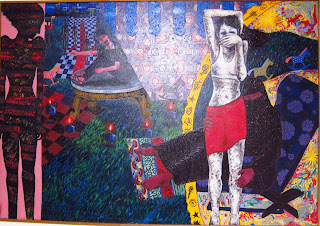Absurd(C)ity @ NVAG
A respectable attempt to trace Surrealism’s influence on local visual arts, is corrupted by the mingling of immature works with established artists, no organised groupings, and an absurd exhibition title. Originating as a literal movement, Surrealism encourages the unbridled expression of the subconscious. However, art development over the past century has relegated this philosophical assertion, to a simplistic juxtaposition of imagery that make people go “WTF?” This intention is obvious in Samsudin Wahab’s horse head that protrudes from a high brick wall, an installation as pointless as Damien Hirst’s shark in a formaldehyde tank. The same can be said about Khairul Azmir Shoib, whose up-cycled wood sculptures are more Corpse Bride than surreal.
 |
| Chang Yoong Chia - Happy Garden (2005) |
In Malaysian modern art, a surreal tendency is seen in the naked red men of Zulkifli Dahalan’s ‘Kedai-Kedai’ and Anthony Lau’s fiery head sculpture. A hellish mood similarly pervades the paintings of couple Tan Chin Kwan and Eng Hwee Chu, where emotional gesturing and daring use of colour create a disconcerting effect. Hamir Soib’s monumental image of an evil clown, projects a nightmarish panorama that sneers sinisterly upon its audience, who ponders the context of this work in this exhibition. Classifications aside, the Surrealist method of free association is best exemplified in Imanordin Mohd Shah’s ‘Di Belakang’, where dangling limbs emerge from the clothesline in this dream-like scene.
 |
| Eng Hwee Chu - Black Moon (1995) |
Ilham Fadhli is showcased as the contemporary champion of this style, with his well-painted moody landscapes and Lilliputian figures. Kojek’s newer works demonstrate a more harmonious palette, perhaps influenced by wife Azliza Ayob’s pretty collages. The original but raw execution of Haslin Ismail's mecha-fantasies, pays tribute to art in the early 20th century, where papier collé and unexpected imagery were popular. Chang Yoong Chia’s ceramic plates comment on China and being Chinese, a curious inclusion among this collection and exhibited together with his giant rabbit painting. Chan Kok Hooi illustrates a gross allegory which introduce absurd characters and nonsensical details into his crowded canvas, a recipe of success that has unfortunately found young followers in Tey Beng Tze and Lim Keh Soon.
 |
| Imanordin Mohd Shah - Di Belakang (1994) |
Exhibited also are a collection of prints by significant proponents of printmaking, such as Lee Kian Seng, Ilse Noor, and Raja Zahabuddin. Long Thien Shih contributes 3 works that pay homage to Salvador Dalí, where blue skies and unique perspectives, form the background for unexpectedly juxtaposed elements. Yee I-Lann's cleverly manipulated photographs of bridges and waste, look unfortunately dated under a glaring spotlight. The decision to feature many young artists dilutes the show’s impact, the major culprits being Meme and Shahrul Hisham, whose works proliferate the show but are self-serving and visually flat. Who you know matters is an inevitable suspicion in this project, where an artist like Shahril Nizam could have contributed more, whose drawings have a higher aesthetic value and emotional resonance with the exhibition theme.
 |
| Long Thieh Shih - Western Figures in Oriental Clouds and Waves (1970) |
As Alexandra Tan observed, “...surrealism exists elsewhere as idiosyncratic cultural movements or schools of art – France and Spain in the 1920s, and more recently in China and Yogyakarta – it might be beneficial not only to think about surrealism in relation to other artistic styles but how or why it exists in a Malaysian context.” This intention to capture a relevant snapshot of an aesthetic preference in the local visual arts, is nullified by the lackadaisical curatorial effort, evident from the lack of explanatory texts and demarcation of artworks into logical groups. This unrealised ambition is perhaps, what is most absurd, about this exhibition.
 |
| Haslin Ismail - The Way It All Works (2010) [Pictures from Today & Tomorrow] |
Comments
Post a Comment